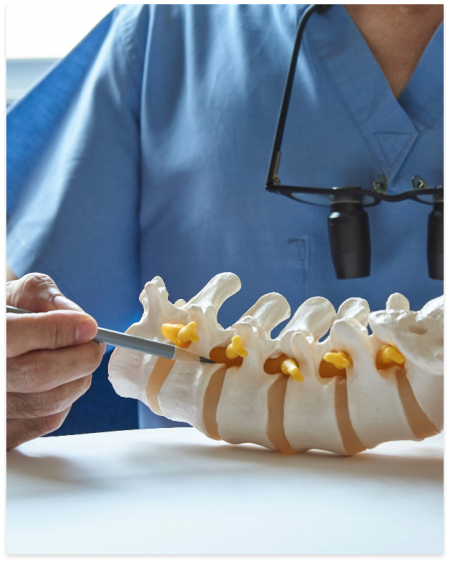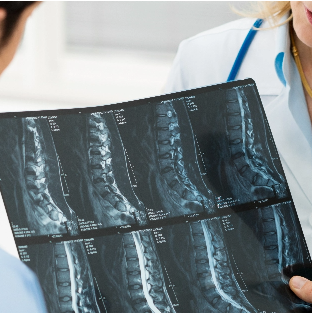
Motion preservation refers to surgical methods that can be used in place of conventional spinal fusion. The goal of these methods is to preserve the natural movement of the spine in the impacted area. One of the main goals of treatment is to preserve range of motion or maintain normal, or near to normal motion. Patients with spine disorders that require surgery first go through a physical exam, then other imaging techniques are applied such as electromyography (EMG), X-ray, MRI scan, CT scan, as well as various blood and bone density tests. A patient’s disease condition (and severity) will influence the treatment recommendation, but Dr. Jeremy Smith’s goal is to provide patients with a well-informed set of options.
Motion preservation spine surgery refers to a variety of surgical techniques aimed at treating spinal disorders while maintaining or restoring normal spinal motion. Unlike traditional fusion procedures, which immobilize the affected spinal segments, motion preservation surgeries seek to preserve the natural movement of the spine. This approach can help alleviate pain and maintain spinal function, leading to better outcomes and improved quality of life for patients.
Disc replacement is a surgical procedure. When an intervertebral disc in the spine has begun to degenerate, it can be replaced with an artificial disc implant. This surgery can occur in the lumbar or cervical spine and is known as an arthroplasty. Disc replacement can offer a long-lasting treatment response to a damaged or dying spinal disc. Before total disc replacement was available, spinal fusion was the surgical norm most widely accepted as the tool used to resolve pain in the spine caused by a degenerated disc. However, fusion eliminates movement in the injured segment of the spine, which then may cause stress on the surrounding vertebrae.



Total disc replacement was developed as an alternative to fusion. Artificial – or manufactured – discs are designed to support the spine, and still allow for forward and backward bending as well as twisting and side-to-side movement. Total disc replacement, while more technically demanding during surgery than fusion, allows for movement to still be possible in the injured section of the spine and thus, does not put undue stress on other areas.
Cervical disc replacement replaces your natural cervical disc with an artificial one. This surgery restores normal neck movements to a patient and reduces the likelihood of degeneration of adjacent discs.
Lumbar disc replacement replaces your natural lumbar disc with an artificial one. It restores normal movement in the spine between the lowest ribs and the pelvis and reduces the likelihood of degeneration of adjacent discs.
A cervical laminoplasty is a procedure that reshapes and repositions bone in order to relieve stress on the cervical spinal nerves – the surgery essentially enlarges the spinal canal. This procedure can relieve pain and other symptoms caused by nerve compression. Cervical laminoplasty is a non-fusion, decompression procedure, and is most commonly indicated for patients with multilevel stenosis.



Lorem ipsum dolor sit amet, consectetur adipiscing elit, sed do eiusmod tempor incididunt ut labore et dolore magna aliqua. Ut enim ad minim veniam, quis nostrud exercitation ullamco laboris nisi ut aliquip ex ea commodo consequat. Duis aute irure dolor in reprehenderit in voluptate velit esse cillum dolore eu fugiat nulla pariatur. Excepteur sint occaecat cupidatat non proident, sunt in culpaest laborum.
Lorem ipsum dolor sit amet, consectetur adipiscing elit, sed do eiusmod tempor incididunt ut labore et dolore magna aliqua. Ut enim ad minim veniam, quis nostrud exercitation ullamco laboris consequat.
Lorem ipsum dolor sit amet, consectetur adipiscing elit, sed do eiusmod tempor incididunt ut labore et dolore magna aliqua. Ut enim ad minim veniam, quis nostrud exercitation ullamco laboris consequat.
Lorem ipsum dolor sit amet, consectetur adipiscing elit, sed do eiusmod tempor incididunt ut labore et dolore magna aliqua. Ut enim ad minim veniam, quis nostrud exercitation ullamco laboris consequat.
Lamina are leaf-like layers of bone – also referred to as a “plate” or “roof” or “layer” – that make up part of the structure of a vertebrae. When this area is impacted, and too much pressure is then put on the spinal nerves, a laminectomy may be performed to relieve pressure and pain. This procedure is done to decompress the area for the spinal cord and nerves, so that the patient may feel relief. A laminectomy is a major spine operation that can create residual scar tissue and may result in post laminectomy syndrome. Depending on the problem, more conservative treatments may be a more viable route for treatment.



A laminectomy may be performed in two ways – through an open surgery (laminectomy) or a keyhole surgery (foraminotomy). The removal of the lamina, or the arch of the vertebral bone that protects the spinal canal, may be the most effective treatment for pain relief from certain spinal conditions.
A cervical foraminotomy is generally recommended when a spinal condition in the neck region is accompanied by nerve damage that results in numbness or weakness in the arms. During the procedure a portion of the vertebrae is surgically removed via minimally invasive techniques to relieve pressure put on the nerves.
A thoracic laminectomy is generally recommended when a spinal condition in the mid-back region is causing pain that is not responding to more conservative measures. Non-surgical alternatives to a thoracic laminectomy may include: pain management strategies, physical therapy, neurotomy, a spinal cord stimulator, or an intrathecal pain pump. During the procedure a portion of the vertebrae is surgically removed to relieve pressure put on the nerves.
During a lumbar laminectomy, the “roof” of a spinal vertebrae is surgically removed to relieve pressure put on the nerves. This procedure may be recommended by your doctor if other treatments fail to relieve pain such as conservative, non-surgical treatments and/or less-invasive surgical options.
Coflex is a titanium alloy device that is inserted into the spine in order to preserve lumbar motion and to provide support to the spine. Coflex surgery is a neurological procedure wherein the Coflex Interlaminar Stabilization device is implanted. This motion-preserving and minimally invasive procedure is often used in treating patients with spinal stenosis, who have developed bone spurs or experience wear and tear in the spine due to aging.

Microdiscectomy (also called microdecompression) is a minimally invasive surgical procedure typically performed to alleviate pain caused by pressure or stress being put on the nerve root. It is effective for relieving extremity pain and back pain caused by a herniated disc. Portions of the herniated disc are removed during surgery, in order to relieve pressure on the spinal nerve structures.
How does motion preservation spine surgery differ from traditional fusion surgery?
Unlike traditional fusion surgery, which fuses two or more vertebrae together to stabilize the spine, motion preservation spine surgery aims to maintain or restore natural spinal motion. Techniques such as artificial disc replacement, dynamic stabilization, and interspinous process devices are used to treat spinal conditions while preserving mobility. By allowing the spine to retain its natural flexibility, patients may experience reduced pain and improved functional outcomes compared to fusion procedures.
What conditions can be treated with motion preservation spine surgery?
Motion preservation spine surgery can be used to treat a variety of spinal conditions, including degenerative disc disease, herniated discs, spinal stenosis, and facet joint arthritis. These procedures are designed to address symptoms such as pain, numbness, tingling, and weakness by restoring normal spinal function while minimizing the need for fusion and preserving motion in the affected segments.
What are the benefits of motion preservation spine surgery?
Motion preservation spine surgery offers several potential benefits compared to traditional fusion procedures. By preserving spinal motion, patients may experience quicker recovery times, reduced risk of adjacent segment degeneration, and improved overall functional outcomes. Additionally, maintaining mobility in the spine can help patients return to their normal activities with less postoperative pain and stiffness, leading to a better quality of life.
Am I a candidate for motion preservation spine surgery?
Determining whether you are a candidate for motion preservation spine surgery requires a thorough evaluation by a spine specialist. Factors such as the extent of your spinal condition, your overall health, and your lifestyle goals will be taken into consideration when determining the most appropriate treatment approach. If you are experiencing symptoms related to a spinal disorder and are seeking alternatives to traditional fusion surgery, discussing your options with a qualified spine surgeon can help determine if motion preservation surgery is right for you.
Why is spine surgery a last resort?
Spine surgery is often considered a last resort due to the complex nature of the spine and the potential risks involved. Non-surgical treatments such as physical therapy, medication, and injections are typically explored first to manage spinal conditions. Surgery may be recommended when conservative measures fail to provide adequate relief or when the condition significantly impairs quality of life. Additionally, surgery may be reserved for cases where the benefits outweigh the potential risks and where other options have been exhausted.
What is the difference between spinal immobilization and spinal motion restriction?
Spinal immobilization involves restricting all movement of the spine, typically achieved through methods such as braces or casts, often used immediately following traumatic spinal injuries to prevent further damage. On the other hand, spinal motion restriction allows controlled movement while still providing support and stability to the spine. Techniques such as dynamic stabilization or artificial disc replacement aim to preserve spinal motion while addressing underlying spinal conditions, offering a middle ground between immobilization and unrestricted motion.
What are motion preservation devices?
Motion preservation devices are implants or prosthetics designed to maintain or restore natural spinal motion while treating spinal disorders. These devices include artificial discs, dynamic stabilization systems, and interspinous process spacers. They are used in motion preservation spine surgery to replace damaged or degenerated spinal structures, allowing for continued flexibility and function in the affected spinal segments.
Do you lose range of motion following a spinal fusion?
Yes, spinal fusion surgery typically results in a loss of range of motion in the fused spinal segments. Fusion involves joining two or more vertebrae together, which eliminates movement at those segments. While fusion can effectively stabilize the spine and alleviate symptoms, it may also restrict flexibility and motion in the treated area. However, adjacent segments may compensate for the loss of motion to some extent.
Can spinal instability be fixed?
Yes, spinal instability can often be corrected through surgical intervention. Surgical techniques such as spinal fusion, dynamic stabilization, or vertebral column resection can be used to stabilize the spine and restore proper alignment and function. The specific approach depends on the underlying cause and extent of instability, as well as the patient's overall health and treatment goals.
What is the most common spine surgery for motion preservation?
Artificial disc replacement (ADR) is one of the most common spine surgeries for motion preservation. During ADR, the damaged or degenerated spinal disc is replaced with an artificial prosthesis, allowing for continued motion and flexibility in the treated segment. This procedure is often used to treat conditions such as degenerative disc disease while preserving spinal motion and function.
Why can you not bend after spine surgery?
Bending restrictions after spine surgery are typically imposed to protect the surgical site and promote proper healing. Excessive bending or twisting of the spine can put stress on the surgical hardware or incision site, increasing the risk of complications such as infection, implant failure, or delayed healing. Following your surgeon's instructions regarding bending restrictions is crucial for ensuring a successful recovery and optimal outcomes.











